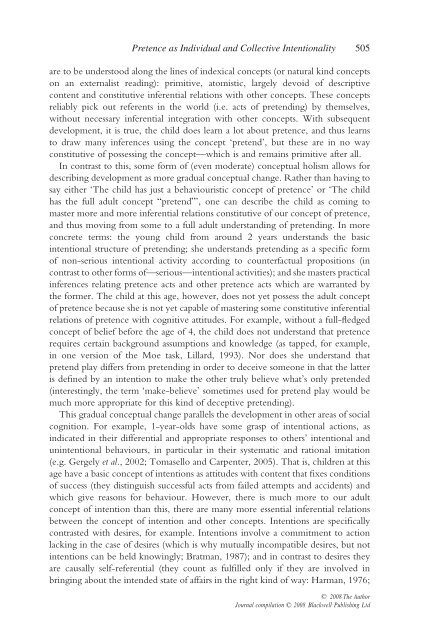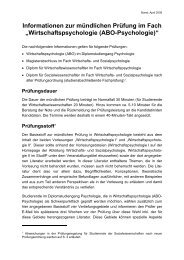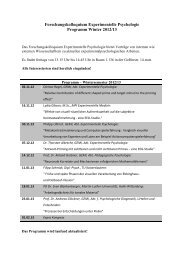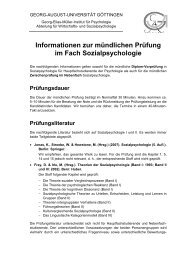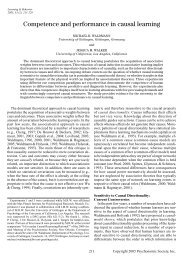Pretence as Individual and Collective Intentionality
Pretence as Individual and Collective Intentionality
Pretence as Individual and Collective Intentionality
Create successful ePaper yourself
Turn your PDF publications into a flip-book with our unique Google optimized e-Paper software.
<strong>Pretence</strong> <strong>as</strong> <strong>Individual</strong> <strong>and</strong> <strong>Collective</strong> <strong>Intentionality</strong> 50 5<br />
are to be understood along the lines of indexical concepts (or natural kind concepts<br />
on an externalist reading): primitive, atomistic, largely devoid of descriptive<br />
content <strong>and</strong> constitutive inferential relations with other concepts. These concepts<br />
reliably pick out referents in the world (i.e. acts of pretending) by themselves,<br />
without necessary inferential integration with other concepts. With subsequent<br />
development, it is true, the child does learn a lot about pretence, <strong>and</strong> thus learns<br />
to draw many inferences using the concept ‘ pretend ’ , but these are in no way<br />
constitutive of possessing the concept — which is <strong>and</strong> remains primitive after all.<br />
In contr<strong>as</strong>t to this, some form of (even moderate) conceptual holism allows for<br />
describing development <strong>as</strong> more gradual conceptual change. Rather than having to<br />
say either ‘ The child h<strong>as</strong> just a behaviouristic concept of pretence ’ or ‘ The child<br />
h<strong>as</strong> the full adult concept “ pretend ” ’ , one can describe the child <strong>as</strong> coming to<br />
m<strong>as</strong>ter more <strong>and</strong> more inferential relations constitutive of our concept of pretence,<br />
<strong>and</strong> thus moving from some to a full adult underst<strong>and</strong>ing of pretending. In more<br />
concrete terms: the young child from around 2 years underst<strong>and</strong>s the b<strong>as</strong>ic<br />
intentional structure of pretending; she underst<strong>and</strong>s pretending <strong>as</strong> a specifi c form<br />
of non-serious intentional activity according to counterfactual propositions (in<br />
contr<strong>as</strong>t to other forms of — serious — intentional activities); <strong>and</strong> she m<strong>as</strong>ters practical<br />
inferences relating pretence acts <strong>and</strong> other pretence acts which are warranted by<br />
the former. The child at this age, however, does not yet possess the adult concept<br />
of pretence because she is not yet capable of m<strong>as</strong>tering some constitutive inferential<br />
relations of pretence with cognitive attitudes. For example, without a full-fl edged<br />
concept of belief before the age of 4, the child does not underst<strong>and</strong> that pretence<br />
requires certain background <strong>as</strong>sumptions <strong>and</strong> knowledge (<strong>as</strong> tapped, for example,<br />
in one version of the Moe t<strong>as</strong>k, Lillard, 1993 ). Nor does she underst<strong>and</strong> that<br />
pretend play differs from pretending in order to deceive someone in that the latter<br />
is defi ned by an intention to make the other truly believe what ’ s only pretended<br />
(interestingly, the term ‘ make-believe ’ sometimes used for pretend play would be<br />
much more appropriate for this kind of deceptive pretending).<br />
This gradual conceptual change parallels the development in other are<strong>as</strong> of social<br />
cognition. For example, 1-year-olds have some gr<strong>as</strong>p of intentional actions, <strong>as</strong><br />
indicated in their differential <strong>and</strong> appropriate responses to others ’ intentional <strong>and</strong><br />
unintentional behaviours, in particular in their systematic <strong>and</strong> rational imitation<br />
(e.g. Gergely et al. , 2002; Tom<strong>as</strong>ello <strong>and</strong> Carpenter, 2005 ). That is, children at this<br />
age have a b<strong>as</strong>ic concept of intentions <strong>as</strong> attitudes with content that fi xes conditions<br />
of success (they distinguish successful acts from failed attempts <strong>and</strong> accidents) <strong>and</strong><br />
which give re<strong>as</strong>ons for behaviour. However, there is much more to our adult<br />
concept of intention than this, there are many more essential inferential relations<br />
between the concept of intention <strong>and</strong> other concepts. Intentions are specifi cally<br />
contr<strong>as</strong>ted with desires, for example. Intentions involve a commitment to action<br />
lacking in the c<strong>as</strong>e of desires (which is why mutually incompatible desires, but not<br />
intentions can be held knowingly; Bratman, 1987 ); <strong>and</strong> in contr<strong>as</strong>t to desires they<br />
are causally self-referential (they count <strong>as</strong> fulfi lled only if they are involved in<br />
bringing about the intended state of affairs in the right kind of way: Harman, 1976;<br />
© 2008 The Author<br />
Journal compilation © 2008 Blackwell Publishing Ltd


